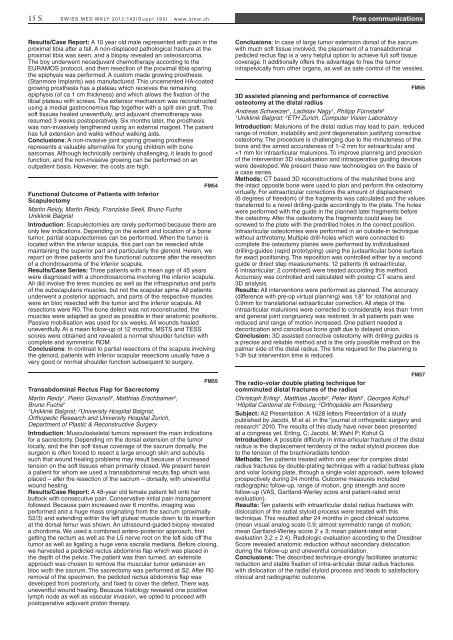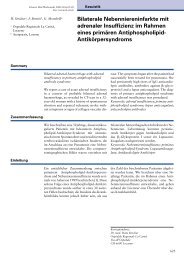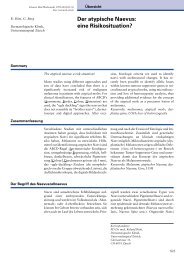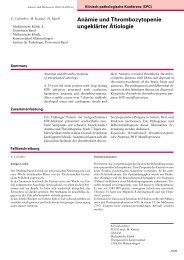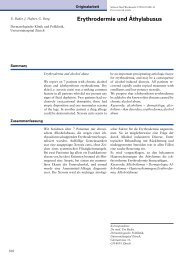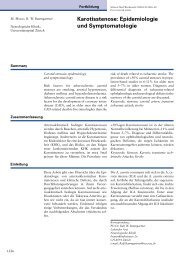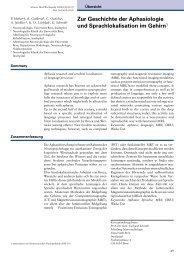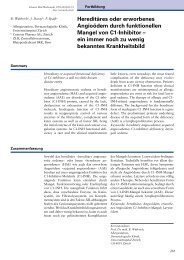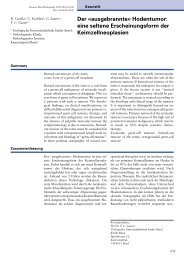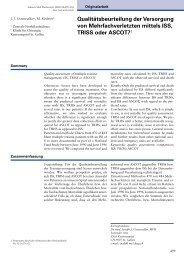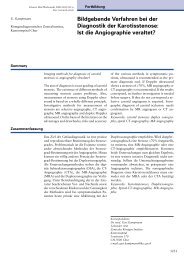SMW Supplementum 193 - Swiss Medical Weekly
SMW Supplementum 193 - Swiss Medical Weekly
SMW Supplementum 193 - Swiss Medical Weekly
You also want an ePaper? Increase the reach of your titles
YUMPU automatically turns print PDFs into web optimized ePapers that Google loves.
15 S SWiSS Med Wkly 2012;142(Suppl <strong>193</strong>) · www.smw.ch Free communications<br />
Results/Case Report: A 10 year old male represented with pain in the<br />
proximal tibia after a fall. A non-displaced pathological fracture at the<br />
proximal tibia was seen, and a biopsy revealed an osteosarcoma.<br />
The boy underwent neoadjuvant chemotherapy according to the<br />
EURAMOS protocol, and then resection of the proximal tibia sparing<br />
the epiphysis was performed. A custom made growing prosthesis<br />
(Stanmore Implants) was manufactured. This uncemented HA-coated<br />
growing prosthesis has a plateau which receives the remaining<br />
epiphysis (of ca 1 cm thickness) and which allows the fixation of the<br />
tibial plateau with screws. The extensor mechanism was reconstructed<br />
using a medial gastrocnemius flap together with a split skin graft. The<br />
soft tissues healed uneventfully, and adjuvant chemotherapy was<br />
resumed 3 weeks postoperatively. Six months later, the prosthesis<br />
was non-invasively lengthened using an external magnet. The patient<br />
has full extension and walks without walking aids.<br />
Conclusions: A non-invasive joint sparing growing prosthesis<br />
represents a valuable alternative for young children with bone<br />
sarcomas. Although technically certainly challenging, it leads to good<br />
function, and the non-invasive growing can be performed on an<br />
outpatient basis. However, the costs are high.<br />
FM54<br />
Functional Outcome of Patients with Inferior<br />
Scapulectomy<br />
Martin Reidy, Martin Reidy, Franziska Seeli, Bruno Fuchs<br />
Uniklinik Balgrist<br />
Introduction: Scapulectomies are rarely performed because there are<br />
only few indications. Depending on the extent and location of a bone<br />
tumor, partial scapulectomies can be performed. When the tumor is<br />
located within the inferior scapula, this part can be resected while<br />
maintaining the superior part and particularly the glenoid. Herein, we<br />
report on three patients and the functional outcome after the resection<br />
of a chondrosaroma of the inferior scapula.<br />
Results/Case Series: Three patients with a mean age of 45 years<br />
were diagnosed with a chondrosarcoma involving the inferior scapula.<br />
All did involve the teres muscles as well as the infraspinatus and parts<br />
of the subscapularis muscles, but not the scapular spine. All patients<br />
underwent a posterior approach, and parts of the respective muscles<br />
were en bloc resected with the tumor and the inferior scapula. All<br />
resections were R0. The bone defect was not reconstructed, the<br />
muscles were adapted as good as possible in their anatomic positions.<br />
Passive mobilisation was used for six weeks. All wounds healed<br />
uneventfully. At a mean follow-up of 12 months, MSTS and TESS<br />
scores were obtained and revealed a normal shoulder function with<br />
complete and symmetric ROM.<br />
Conclusions: In contrast to partial resections of the scapula involving<br />
the glenoid, patients with inferior scapular resections usually have a<br />
very good or normal shoulder function subsequent to surgery.<br />
FM55<br />
Transabdominal Rectus Flap for Sacrectomy<br />
Martin Reidy1 , Pietro Giovanoli2 , Matthias Erschbamer2 ,<br />
Bruno Fuchs2 1Uniklinik Balgrist; 2University Hospital Balgrist,<br />
Orthopedic Research and University Hospital Zurich,<br />
Department of Plastic & Reconstructive Surgery<br />
Introduction: Musculoskeletal tumors represent the main indications<br />
for a sacrectomy. Depending on the dorsal extension of the tumor<br />
locally, and the thin soft tissue coverage of the sacrum dorsally, the<br />
surgeon is often forced to resect a large enough skin and subcutis<br />
such that wound healing problems may result because of increased<br />
tension on the soft tissues when primarily closed. We present herein<br />
a patient for whom we used a transabdominal recuts flap which was<br />
placed – after the resection of the sacrum – dorsally, with uneventful<br />
wound healing.<br />
Results/Case Report: A 48-year old female patient fell onto her<br />
buttock with consecutive pain. Conservative initial pain management<br />
followed. Because pain increased over 6 months, imaging was<br />
performed and a huge mass originating from the sacrum (proximally<br />
S2/3) and extending within the left gluteal muscle down to its insertion<br />
at the dorsal femur was shown. An ultrasound-guided biopsy revealed<br />
a chordoma. We used a combined antero-posterior approach, first<br />
getting the rectum as well as the L5 nerve root on the left side off the<br />
tumor as well as ligating a huge vena sacralis mediana. Before closing,<br />
we harvested a pedicled rectus abdominis flap which was placed in<br />
the depth of the pelvis. The patient was then turned, an extensile<br />
approach was chosen to remove the muscular tumor extension en<br />
bloc woth the sacrum. The sacrectomy was performed at S2. After R0<br />
removal of the specimen, the pedicled rectus abdominis flap was<br />
developed from posteriorly, and fixed to cover the defect. There was<br />
uneventful wound healing. Because histology revealed one positive<br />
lymph node as well as vascular invasion, we opted to proceed with<br />
postoperative adjuvant proton therapy.<br />
Conclusions: In case of large tumor extension dorsal of the sacrum<br />
with much soft tissue involved, the placement of a transabdominal<br />
pedicled rectus flap is a very helpful option to achieve full soft tissue<br />
coverage. It additionally offers the advantage to free the tumor<br />
intrapelvically from other organs, as well as safe control of the vessles.<br />
FM56<br />
3D assisted planning and performance of corrective<br />
osteotomy at the distal radius<br />
Andreas Schweizer1 , Ladislav Nagy1 , Philipp Fürnstahl2 1 2 Uniklinik Balgrist; ETH Zurich, Computer Vision Laboratory<br />
Introduction: Malunions of the distal radius may lead to pain, reduced<br />
range of motion, instability and joint degeneration justifying corrective<br />
osteotomy. The procedure is challenging due to the minuteness of the<br />
bone and the aimed accurateness of 1–2 mm for extraarticular and<br />


